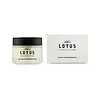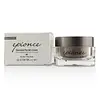What's inside
What's inside
 Key Ingredients
Key Ingredients

 Benefits
Benefits

 Concerns
Concerns

 Ingredients Side-by-side
Ingredients Side-by-side

Water
Skin ConditioningNelumbo Nucifera Leaf Extract
Skin ConditioningGlycerin
HumectantDipropylene Glycol
HumectantCetyl Ethylhexanoate
EmollientCaprylic/Capric Triglyceride
MaskingGlyceryl Stearate
EmollientCetearyl Alcohol
EmollientPentaerythrityl Tetraethylhexanoate
Emollient1,2-Hexanediol
Skin ConditioningBetaine
HumectantDimethicone
EmollientQuercus Acuta Branch/Leaf Extract
Skin ConditioningCyclopentasiloxane
EmollientBeeswax
Emulsion StabilisingSorbitan Stearate
EmulsifyingPEG-100 Stearate
Butylene Glycol
HumectantPolyacrylamide
Palmitic Acid
EmollientEthylhexylglycerin
Skin ConditioningCaprylyl Glycol
EmollientPolysilicone-11
Stearic Acid
CleansingC13-14 Isoparaffin
EmollientCarbomer
Emulsion StabilisingTromethamine
BufferingNylon-12
Silica
AbrasiveHippophae Rhamnoides Oil
EmollientAdenosine
Skin ConditioningLavandula Angustifolia Oil
MaskingCitrus Limon Peel Oil
MaskingLaureth-7
EmulsifyingDisodium EDTA
Ammonium Polyacryloyldimethyl Taurate
Emulsion StabilisingIsohexadecane
EmollientPolysorbate 40
EmulsifyingPEG-10 Dimethicone
Skin ConditioningCitrus Aurantifolia Oil
CleansingEucalyptus Globulus Leaf Oil
PerfumingRosmarinus Officinalis Leaf Oil
MaskingLauric Acid
CleansingMyristic Acid
CleansingCaramel
Cosmetic ColorantJuniperus Mexicana Oil
MaskingChamomilla Recutita Flower Oil
MaskingDextrin
AbsorbentPelargonium Graveolens Flower Oil
MaskingWater, Nelumbo Nucifera Leaf Extract, Glycerin, Dipropylene Glycol, Cetyl Ethylhexanoate, Caprylic/Capric Triglyceride, Glyceryl Stearate, Cetearyl Alcohol, Pentaerythrityl Tetraethylhexanoate, 1,2-Hexanediol, Betaine, Dimethicone, Quercus Acuta Branch/Leaf Extract, Cyclopentasiloxane, Beeswax, Sorbitan Stearate, PEG-100 Stearate, Butylene Glycol, Polyacrylamide, Palmitic Acid, Ethylhexylglycerin, Caprylyl Glycol, Polysilicone-11, Stearic Acid, C13-14 Isoparaffin, Carbomer, Tromethamine, Nylon-12, Silica, Hippophae Rhamnoides Oil, Adenosine, Lavandula Angustifolia Oil, Citrus Limon Peel Oil, Laureth-7, Disodium EDTA, Ammonium Polyacryloyldimethyl Taurate, Isohexadecane, Polysorbate 40, PEG-10 Dimethicone, Citrus Aurantifolia Oil, Eucalyptus Globulus Leaf Oil, Rosmarinus Officinalis Leaf Oil, Lauric Acid, Myristic Acid, Caramel, Juniperus Mexicana Oil, Chamomilla Recutita Flower Oil, Dextrin, Pelargonium Graveolens Flower Oil
Water
Skin ConditioningButylene Glycol
HumectantTrisiloxane
Skin ConditioningPetrolatum
EmollientLimnanthes Alba Seed Oil
Skin ConditioningCarthamus Tinctorius Seed Oil
MaskingC10-30 Cholesterol/Lanosterol Esters
EmulsifyingGlycerin
HumectantPPG-2 Myristyl Ether Propionate
EmollientBeeswax
Emulsion StabilisingOlea Europaea Fruit Oil
MaskingC13-14 Isoparaffin
EmollientLaureth-7
EmulsifyingPolyacrylamide
Glyceryl Stearate
EmollientMalic Acid
BufferingPEG-100 Stearate
Pyrus Malus Fruit Extract
Skin ConditioningC12-15 Alkyl Benzoate
AntimicrobialCamphor
MaskingCaprylyl Glycol
EmollientCetearyl Alcohol
EmollientCetyl Alcohol
EmollientCitral
PerfumingCitrus Aurantium Dulcis Peel Oil
MaskingCitrus Limon Peel Oil
MaskingCymbopogon Citratus Leaf Oil
MaskingEthylene Brassylate
MaskingEthylhexylglycerin
Skin ConditioningHexylene Glycol
EmulsifyingLavandula Hybrida Oil
EmollientLimonene
PerfumingLinalool
PerfumingLinalyl Acetate
MaskingLinum Usitatissimum Seed Oil
PerfumingLitsea Cubeba Fruit Oil
MaskingOctanal
PerfumingPersea Gratissima Oil
Skin ConditioningPhenoxyethanol
PreservativePhoenix Dactylifera Fruit Extract
EmollientPhytosphingosine
Skin ConditioningPhytosterols
Skin ConditioningPinene
MaskingPolysorbate 60
EmulsifyingQuercetin
AntioxidantRosa Canina Fruit Oil
EmollientSodium Hyaluronate
HumectantSodium Hydroxide
BufferingWater, Butylene Glycol, Trisiloxane, Petrolatum, Limnanthes Alba Seed Oil, Carthamus Tinctorius Seed Oil, C10-30 Cholesterol/Lanosterol Esters, Glycerin, PPG-2 Myristyl Ether Propionate, Beeswax, Olea Europaea Fruit Oil, C13-14 Isoparaffin, Laureth-7, Polyacrylamide, Glyceryl Stearate, Malic Acid, PEG-100 Stearate, Pyrus Malus Fruit Extract, C12-15 Alkyl Benzoate, Camphor, Caprylyl Glycol, Cetearyl Alcohol, Cetyl Alcohol, Citral, Citrus Aurantium Dulcis Peel Oil, Citrus Limon Peel Oil, Cymbopogon Citratus Leaf Oil, Ethylene Brassylate, Ethylhexylglycerin, Hexylene Glycol, Lavandula Hybrida Oil, Limonene, Linalool, Linalyl Acetate, Linum Usitatissimum Seed Oil, Litsea Cubeba Fruit Oil, Octanal, Persea Gratissima Oil, Phenoxyethanol, Phoenix Dactylifera Fruit Extract, Phytosphingosine, Phytosterols, Pinene, Polysorbate 60, Quercetin, Rosa Canina Fruit Oil, Sodium Hyaluronate, Sodium Hydroxide
Ingredients Explained
These ingredients are found in both products.
Ingredients higher up in an ingredient list are typically present in a larger amount.
Beeswax is natural wax produced by honey bees and can be synthetically created. It consists mainly of fatty acid esters and long-chain alcohols.
In cosmetics, beeswax is a emollient. Due to its waxy structure, it creates a protective barrier. This barrier prevents water from evaporating off the skin.
This may not be a good ingredient for oily skin. We recommend speaking with a professional if you have concerns.
Beeswax cannot be removed with water, but can be taken off with an oil cleanser.
Beeswax is also antiseptic and contains vitamin A.
Learn more about BeeswaxButylene Glycol (or BG) is used within cosmetic products for a few different reasons:
Overall, Butylene Glycol is a safe and well-rounded ingredient that works well with other ingredients.
Though this ingredient works well with most skin types, some people with sensitive skin may experience a reaction such as allergic rashes, closed comedones, or itchiness.
Learn more about Butylene GlycolThis ingredient is also known as "C13-14 Isoalkane".
C13-14 Isoparaffin is created from petroleum-based mineral oils. It is an emollient and helps thicken a product.
As an emollient, it helps keep the skin soft and smooth by creating a barrier on top. This barrier traps moisture in, keeping the skin hydrated.
C13-14 Isoparaffin may not be fungal-acne safe.
Learn more about C13-14 IsoparaffinCaprylyl Glycol is a humectant and emollient, meaning it attracts and preserves moisture.
It is a common ingredient in many products, especially those designed to hydrate skin. The primary benefits are retaining moisture, skin softening, and promoting a healthy skin barrier.
Though Caprylyl Glycol is an alcohol derived from fatty acids, it is not the kind that can dry out skin.
This ingredient is also used as a preservative to extend the life of products. It has slight antimicrobial properties.
Learn more about Caprylyl GlycolCetearyl alcohol is a mixture of two fatty alcohols: cetyl alcohol and stearyl alcohol. It is mainly used as an emulsifier. Emulsifiers help prevent the separation of oils and products. Due to its composition, it can also be used to thicken a product or help create foam.
Cetearyl alcohol is an emollient. Emollients help soothe and hydrate the skin by trapping moisture.
Studies show Cetearyl alcohol is non-toxic and non-irritating. The FDA allows products labeled "alcohol-free" to have fatty alcohols.
This ingredient is usually derived from plant oils such as palm, vegetable, or coconut oils. There is debate on whether this ingredient will cause acne.
Due to the fatty acid base, this ingredient may not be Malassezia folliculitis safe.
Learn more about Cetearyl AlcoholCitrus Limon Peel Oil is created from the peels of the lemon. It is used to add a lemon-scent to products. Lemon peel oil also has antibacterial, antifungal, and antioxidant properties. However, it may also cause phototoxicity and sensitize skin.
Lemon peel oil contains limonene, a skin sensitizing ingredient. Another component is furanocoumarin, which induces phototoxicity in skin.
Furanocoumarins bind and destabilize your DNA to increase the rate of sunburn.
Most reputable companies will remove furanocoumarins from their formulations.
Learn more about Citrus Limon Peel OilEthylhexylglycerin (we can't pronounce this either) is commonly used as a preservative and skin softener. It is derived from glyceryl.
You might see Ethylhexylglycerin often paired with other preservatives such as phenoxyethanol. Ethylhexylglycerin has been found to increase the effectiveness of these other preservatives.
Glycerin is already naturally found in your skin. It helps moisturize and protect your skin.
A study from 2016 found glycerin to be more effective as a humectant than AHAs and hyaluronic acid.
As a humectant, it helps the skin stay hydrated by pulling moisture to your skin. The low molecular weight of glycerin allows it to pull moisture into the deeper layers of your skin.
Hydrated skin improves your skin barrier; Your skin barrier helps protect against irritants and bacteria.
Glycerin has also been found to have antimicrobial and antiviral properties. Due to these properties, glycerin is often used in wound and burn treatments.
In cosmetics, glycerin is usually derived from plants such as soybean or palm. However, it can also be sourced from animals, such as tallow or animal fat.
This ingredient is organic, colorless, odorless, and non-toxic.
Glycerin is the name for this ingredient in American English. British English uses Glycerol/Glycerine.
Learn more about GlycerinGlyceryl Stearate is a mix of glycerin and stearic acid.
It is used to stabilize the mixing of water and oil ingredients. By preventing these ingredients from separating, it can help elongate shelf life. It can also help thicken the product's texture.
As an emollient, it helps soften skin and supports barrier-replenishing ingredients.
In cosmetics, Glyceryl Stearate is often made from vegetable oils or synthetically produced.
This ingredient may not be fungal-acne safe
Fun fact: The human body also creates Glyceryl Stearate naturally.
Learn more about Glyceryl StearateLaureth-7 is created by the ethoxylation of lauryl alcohol using ethylene oxide. Lauryl alcohol is a fatty alcohol with hydrating properties.
This ingredient is an emulsifier and cleansing ingredient. As an emulsifier, it is used to prevent ingredients from separating. It also helps cleanse the skin by gathering dirt, oil, and pollutants to be rinsed away.
Peg-100 Stearate is an emollient and emulsifier. As an emollient, it helps keep skin soft by trapping moisture in. On the other hand, emulsifiers help prevent oil and water from separating in a product.
PEGS are a hydrophilic polyether compound . There are 100 ethylene oxide monomers in Peg-100 Stearate. Peg-100 Stearate is polyethylene glycol ester of stearic acid.
Polyacrylamide is a synthetic polymer. It is used to stabilize products and bind ingredients. When hydrated, Polyacrylamide forms a soft gel.
Polyacrylamide is low-toxicity. If source properly, it is deemed safe to use in cosmetics.
It should be noted the precursor to Polyacrylamide is acrylamide. Acrylamide is a carcinogen. Most reputable sources of Polyacrylamide will screen for residual acrylamide to make sure the count is in a safe range. Acrylamide is not able to be absorbed through the skin.
We recommend speaking with a professional if you have concerns.
Learn more about PolyacrylamideWater. It's the most common cosmetic ingredient of all. You'll usually see it at the top of ingredient lists, meaning that it makes up the largest part of the product.
So why is it so popular? Water most often acts as a solvent - this means that it helps dissolve other ingredients into the formulation.
You'll also recognize water as that liquid we all need to stay alive. If you see this, drink a glass of water. Stay hydrated!
Learn more about Water